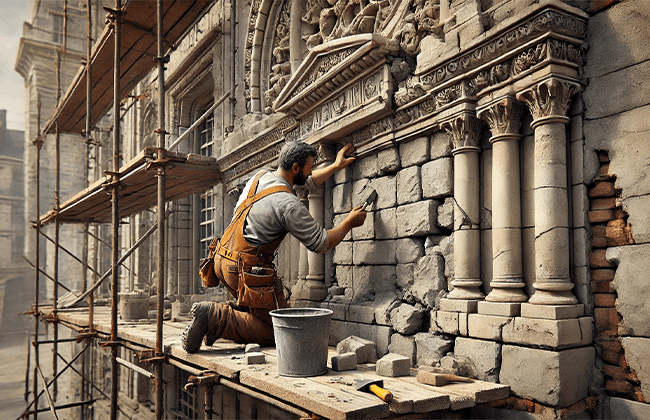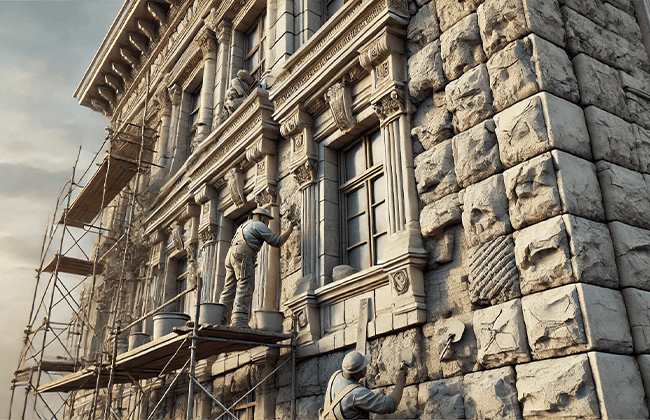A stone façade is a decorative exterior feature of buildings that uses stone, either natural or manufactured, to create a visually appealing and durable surface. Stone façades have been a popular architectural choice for centuries, offering a combination of beauty, durability, and resilience to weather and wear. However, like any exterior building material, stone façades require regular maintenance and occasional repairs to preserve their integrity and appearance.
What is a Stone Façade?
A stone façade refers to a building’s outer layer made of stone materials, providing both aesthetic appeal and structural benefits. This type of façade can be constructed using natural stone, manufactured stone, or thin stone veneer, each offering distinct advantages.
Natural Stone Façade
A natural stone façade uses stones that are quarried and cut to fit the exterior of a building. Common types include granite, limestone, marble, and sandstone. These materials are celebrated for their strength, long-lasting nature, and the ability to provide a building with a timeless, elegant look. Natural stone façades are particularly durable, often lasting for several decades without needing significant repairs, making them an excellent long-term investment.
Manufactured Stone Façade
Manufactured stone is a lightweight, man-made alternative designed to mimic the appearance of natural stone. It is made from concrete and other aggregates that are molded into the shape of real stones, then colored to look like the genuine article. Manufactured stone is less expensive and easier to install than natural stone, but it may not be as durable in the long run.
Thin Stone Veneer Façade
Thin stone veneer uses real stone but in thinner, lighter slices. This type of façade is ideal for modern construction where weight is a concern, such as for high-rise buildings or renovations where adding significant weight to the structure may not be feasible. Thin stone veneer offers the beauty of natural stone with less cost and installation difficulty compared to full-sized stone blocks.
Common Issues with Stone Façades
While stone façades are generally durable, they can still experience wear and tear over time due to environmental factors, poor installation, or lack of maintenance. Some of the most common issues include:
Cracking and Chipping
Over time, cracking and chipping are common issues in stone façades, especially in climates with frequent temperature changes. Stones expand and contract with fluctuating temperatures, leading to stress fractures. This can occur more often with manufactured stones that are more susceptible to environmental changes than natural stones.
Loose or Falling Stones
If the stone façade was not properly installed or if the adhesive or mortar holding the stones together deteriorates over time, stones may become loose or even fall off. This issue is particularly common in older buildings where the mortar has been exposed to decades of weathering.
Water Damage
Without proper sealing, water can seep behind the stone façade and cause damage to both the façade and the underlying structure. Water intrusion leads to problems such as mold, mildew, and structural degradation. Stones can also develop stains or discoloration due to constant exposure to moisture, making the façade look aged or damaged.
Efflorescence
This is a condition where white, powdery deposits appear on the stone surface due to water moving through the stone and evaporating, leaving behind salt deposits. Efflorescence is a common issue in stone façades exposed to moisture and can affect the overall appearance of the building.
How to Repair a Stone Façade

Repairing a stone façade can involve minor fixes like filling in cracks or major tasks like replacing loose or missing stones. It is important to address issues early to prevent more serious structural damage over time.
Repairing Cracks and Chips
Cracks and chips can develop in a stone façade due to temperature changes, impact damage, or natural wear and tear. Here’s how to repair these:
- Step 1: Start by cleaning the affected area, removing dirt, dust, and any loose fragments of stone or mortar.
- Step 2: Use a stone repair epoxy or mortar filler to patch up the cracks. Choose a product that matches the stone color to ensure a seamless repair.
- Step 3: Apply the filler into the cracks using a putty knife, making sure the material fills the entire crack and extends slightly over the surface.
- Step 4: Smooth the surface of the repair, ensuring that it blends with the surrounding stone.
- Step 5: Allow the patch to dry for the recommended time before exposing it to water or further stress.
Replacing Loose or Missing Stones
When stones become loose or fall off, the repair process is slightly more involved but still manageable:
- Step 1: Remove any loose mortar or adhesive from the wall where the stone was originally attached.
- Step 2: Apply a fresh layer of stone adhesive or mortar to the back of the replacement stone and the wall surface.
- Step 3: Press the stone into place, aligning it with the surrounding stones to maintain the uniform appearance of the façade.
- Step 4: Fill any gaps around the stone with additional mortar, smoothing it out to match the rest of the façade.
- Step 5: Let the adhesive set for the specified time before allowing any weight or pressure on the stone.
Addressing Water Damage
Water damage is a serious concern for stone façades. If you notice signs of water intrusion:
- Step 1: Inspect the affected area to determine if water has caused damage to the underlying structure. If so, consult a professional to assess the extent of the problem.
- Step 2: Reseal the stone façade using a waterproof sealant. This process involves cleaning the stone surface and applying a sealant that repels water, helping to prevent future moisture penetration.
- Step 3: If significant damage has occurred behind the stone, remove the damaged stones, repair the underlying wall, and reinstall the façade with proper waterproofing layers in place.
Fixing Efflorescence
Efflorescence can be treated by cleaning the affected stone with a mixture of water and vinegar or a specialized efflorescence cleaner. After cleaning, ensure the stone is properly sealed to prevent future water seepage.
Preventive Maintenance for Stone Façades
Regular maintenance is crucial for ensuring that your stone façade remains in good condition for decades. Key preventive measures include:
- Annual Cleaning: Use a soft brush or low-pressure water to clean the façade annually, removing dirt, algae, and pollutants that can accumulate over time.
- Sealant Application: Apply a waterproof sealant every 3 to 5 years to protect the stone from moisture, especially in areas prone to rain or snow.
- Inspection After Extreme Weather: After storms, inspect the façade for loose stones or cracks caused by weather conditions. Address these issues immediately to prevent further damage.
- Repair Small Issues Early: Fixing small cracks or chips as soon as they appear can prevent larger, more costly repairs in the future.
Conclusion
A stone façade adds both aesthetic appeal and durability to a building’s exterior, but it requires regular care to stay in optimal condition. By addressing issues like cracks, loose stones, and water damage early, homeowners can prevent further deterioration and expensive repairs. Proper maintenance, including applying sealants and conducting routine inspections, is key to extending the lifespan of the façade. Following these practices ensures that the stone façade remains a long-lasting and beautiful feature.
FAQs
Q: What is a stone façade?
A: A stone façade is an exterior layer made from natural or manufactured stone, used for both decorative and protective purposes on buildings.
Q: How often should stone façades be sealed?
A: It is recommended to apply a water-resistant sealant every 3 to 5 years to prevent moisture from seeping behind the stone and causing damage.
Q: Can I repair a chipped stone on my façade myself?
A: Yes, minor chips and cracks can be repaired using stone epoxy or mortar filler. For larger issues, it’s advisable to consult a professional.
Q: What causes stones to loosen from a façade?
A: Over time, the mortar or adhesive that holds the stones in place can deteriorate due to environmental exposure, especially if the façade is not properly sealed.
Q: How do I prevent water damage to my stone façade?
A: Regularly apply a water-resistant sealant, and ensure that your façade is properly installed with adequate waterproofing behind the stone layer.





